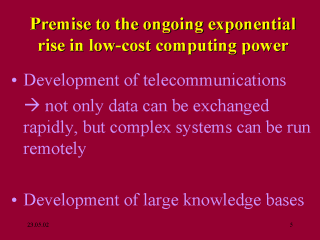| front |1 |2 |3 |4 |5 |6 |7 |8 |9 |10 |11 |12 |13 |14 |15 |16 |17 |18 |19 |20 |21 |22 |23 |24 |25 |26 |27 |28 |29 |review |
 |
- Most recently,
two new factors have added to the ongoing exponential rise in low-cost computing power. These developments have enabled the explosive growth of the Internet, and have enabled complex telemedicine applications including remote in vivo diagnostic analysis as well as teleconsultation. For example, in the United States, recent Internet users number an estimated 110 million, and by 2002, those numbers climbed to approximately 165 million. Complex information sets, such as radiographic pictures, or computerized axial tomography (CAT) scans, can be sent round the world in a real time regime. - The market for health care information technologies (IT) an estimated $13.6 billion in 1997, was predicted to jump to $21 billion in 2000. IT operating budgets are averaging 2.8 % of total operating budgets for integrated delivery systems (IDS) and 3.5 % for larger IDS, a figure that is poised to rise in the next few years. On average, IT accounts for 28.4 % of capital spending and 37.1% of spending in lower- to middle-tier organizations. Experts predict these figures will continue marching upward. |